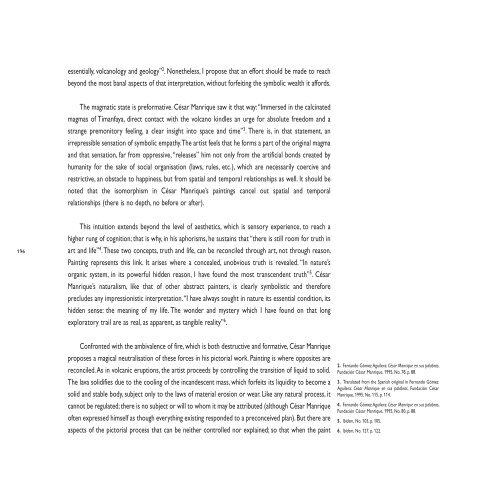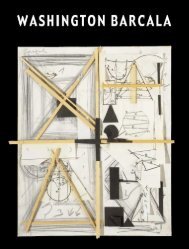VERSIÓN INGLESA ENGLISH VERSION - Fundación César Manrique
VERSIÓN INGLESA ENGLISH VERSION - Fundación César Manrique
VERSIÓN INGLESA ENGLISH VERSION - Fundación César Manrique
Create successful ePaper yourself
Turn your PDF publications into a flip-book with our unique Google optimized e-Paper software.
196<br />
essentially, volcanology and geology” 2 . Nonetheless, I propose that an effort should be made to reach<br />
beyond the most banal aspects of that interpretation, without forfeiting the symbolic wealth it affords.<br />
The magmatic state is preformative. <strong>César</strong> <strong>Manrique</strong> saw it that way: “Immersed in the calcinated<br />
magmas of Timanfaya, direct contact with the volcano kindles an urge for absolute freedom and a<br />
strange premonitory feeling, a clear insight into space and time” 3 . There is, in that statement, an<br />
irrepressible sensation of symbolic empathy. The artist feels that he forms a part of the original magma<br />
and that sensation, far from oppressive, “releases” him not only from the artificial bonds created by<br />
humanity for the sake of social organisation (laws, rules, etc.), which are necessarily coercive and<br />
restrictive, an obstacle to happiness, but from spatial and temporal relationships as well. It should be<br />
noted that the isomorphism in <strong>César</strong> <strong>Manrique</strong>’s paintings cancel out spatial and temporal<br />
relationships (there is no depth, no before or after).<br />
This intuition extends beyond the level of aesthetics, which is sensory experience, to reach a<br />
higher rung of cognition; that is why, in his aphorisms, he sustains that “there is still room for truth in<br />
art and life” 4 . These two concepts, truth and life, can be reconciled through art, not through reason.<br />
Painting represents this link. It arises where a concealed, unobvious truth is revealed. “In nature’s<br />
organic system, in its powerful hidden reason, I have found the most transcendent truth” 5 . <strong>César</strong><br />
<strong>Manrique</strong>’s naturalism, like that of other abstract painters, is clearly symbolistic and therefore<br />
precludes any impressionistic interpretation. “I have always sought in nature its essential condition, its<br />
hidden sense: the meaning of my life. The wonder and mystery which I have found on that long<br />
exploratory trail are as real, as apparent, as tangible reality” 6 .<br />
Confronted with the ambivalence of fire, which is both destructive and formative, <strong>César</strong> <strong>Manrique</strong><br />
proposes a magical neutralisation of these forces in his pictorial work. Painting is where opposites are<br />
reconciled. As in volcanic eruptions, the artist proceeds by controlling the transition of liquid to solid.<br />
The lava solidifies due to the cooling of the incandescent mass, which forfeits its liquidity to become a<br />
solid and stable body, subject only to the laws of material erosion or wear. Like any natural process, it<br />
cannot be regulated; there is no subject or will to whom it may be attributed (although <strong>César</strong> <strong>Manrique</strong><br />
often expressed himself as though everything existing responded to a preconceived plan). But there are<br />
aspects of the pictorial process that can be neither controlled nor explained; so that when the paint<br />
2. Fernando Gómez Aguilera: <strong>César</strong> <strong>Manrique</strong> en sus palabras,<br />
<strong>Fundación</strong> <strong>César</strong> <strong>Manrique</strong>, 1995, No. 78, p. 88.<br />
3. Translated from the Spanish original in Fernando Gómez<br />
Aguilera: <strong>César</strong> <strong>Manrique</strong> en sus palabras, <strong>Fundación</strong> <strong>César</strong><br />
<strong>Manrique</strong>, 1995, No. 115, p. 114.<br />
4. Fernando Gómez Aguilera: <strong>César</strong> <strong>Manrique</strong> en sus palabras,<br />
<strong>Fundación</strong> <strong>César</strong> <strong>Manrique</strong>, 1995, No. 80, p. 88.<br />
5. Ibídem, No. 103, p. 105.<br />
6. Ibídem, No. 127, p. 122.
















![Becas y premios de la Fundación César Manrique [1997-2006]](https://img.yumpu.com/20766851/1/184x260/becas-y-premios-de-la-fundacion-cesar-manrique-1997-2006.jpg?quality=85)
